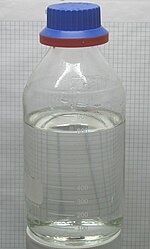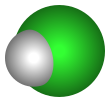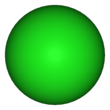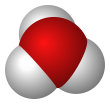
A | B | C | D | E | F | G | H | CH | I | J | K | L | M | N | O | P | Q | R | S | T | U | V | W | X | Y | Z | 0 | 1 | 2 | 3 | 4 | 5 | 6 | 7 | 8 | 9

| |||

| |||
| |||
| |||
| Names | |||
|---|---|---|---|
| IUPAC name
Chlorane[3]
| |||
| Other names | |||
| Identifiers | |||
| ChEMBL | |||
| ChemSpider | |||
| ECHA InfoCard | 100.210.665 | ||
| EC Number |
| ||
| E number | E507 (acidity regulators, ...) | ||
PubChem CID
|
|||
| UNII | |||
| UN number | 1789 | ||
| Properties | |||
| HCl(aq) | |||
| Molar mass | 36.46 g·mol−1 | ||
| Appearance | Colorless, transparent liquid, fumes in air if concentrated | ||
| Odor | Pungent characteristic | ||
| Density | 1.18 g/cm3 | ||
| Melting point | Concentration-dependent – see table | ||
| Boiling point | Concentration-dependent – see table | ||
| log P | 0.00[4] | ||
| Acidity (pKa) | −5.9 (HCl gas)[5] | ||
| Pharmacology | |||
| A09AB03 (WHO) B05XA13 (WHO) | |||
| Hazards | |||
| GHS labelling: | |||
 
| |||
| Danger[6] | |||
| H290, H314, H335[6] | |||
| P260, P280, P303+P361+P353, P305+P351+P338[6] | |||
| NFPA 704 (fire diamond) | |||
| Related compounds | |||
Other anions
|
|||
Related compounds
|
Hydrogen chloride | ||
| Supplementary data page | |||
| Hydrochloric acid (data page) | |||
Except where otherwise noted, data are given for materials in their standard state (at 25 °C , 100 kPa).
| |||
Hydrochloric acid, also known as muriatic acid or spirits of salt, is an aqueous solution of hydrogen chloride (HCl). It is a colorless solution with a distinctive pungent smell. It is classified as a strong acid. It is a component of the gastric acid in the digestive systems of most animal species, including humans. Hydrochloric acid is an important laboratory reagent and industrial chemical.[7][8]
Etymology
Because it was produced from rock salt according to the methods of Johann Rudolph Glauber, hydrochloric acid was historically called by European alchemists spirits of salt or acidum salis (salt acid). Both names are still used, especially in other languages, such as German: Salzsäure, Dutch: Zoutzuur, Swedish: Saltsyra, Finnish: Suolahappo, Spanish: Salfumán, Turkish: Tuz Ruhu, Polish: kwas solny, Hungarian: sósav, Czech: kyselina solná, Japanese: 塩酸 (ensan), Chinese: 盐酸 (yánsuān), and Korean: 염산 (yeomsan).
Gaseous HCl was called marine acid air. The name muriatic acid has the same origin (muriatic means "pertaining to brine or salt", hence muriate means hydrochloride), and this name is still sometimes used.[1][9] The name hydrochloric acid was coined by the French chemist Joseph Louis Gay-Lussac in 1814.[10]
History
9th–10th century
In the early tenth century, the Persian physician and alchemist Abu Bakr al-Razi (c. 865–925, Latin: Rhazes) conducted experiments with sal ammoniac (ammonium chloride) and vitriol (hydrated sulfates of various metals), which he distilled together, thus producing the gas hydrogen chloride.[11] In doing so, al-Razi may have stumbled upon a primitive method for producing hydrochloric acid,[12] as perhaps manifested in the following recipe from his Kitāb al-Asrār ("The Book of Secrets"):
Take equal parts of sweet salt, Bitter salt, Ṭabarzad salt, Andarānī salt, Indian salt, salt of Al-Qilī, and salt of Urine. After adding an equal weight of good crystallised Sal-ammoniac, dissolve by moisture, and distil (the mixture). There will distil over a strong water, which will cleave stone (sakhr) instantly.[13]
However, it appears that in most of his experiments al-Razi disregarded the gaseous products, concentrating instead on the color changes that could be effected in the residue.[14] According to Robert P. Multhauf, hydrogen chloride was produced many times without clear recognition that, by dissolving it in water, hydrochloric acid may be produced.[15]
11th–13th century
Drawing on al-Razi's experiments, the De aluminibus et salibus ("On Alums and Salts"), an eleventh- or twelfth-century Arabic text falsely attributed to al-Razi and translated into Latin by Gerard of Cremona (1144–1187), described the heating of metals with various salts, which in the case of mercury resulted in the production of mercury(II) chloride (corrosive sublimate).[16] In this process, hydrochloric acid actually started to form, but it immediately reacted with the mercury to produce corrosive sublimate. Thirteenth-century Latin alchemists, for whom the De aluminibus et salibus was one of the main reference works, were fascinated by the chlorinating properties of corrosive sublimate, and they soon discovered that when the metals are eliminated from the process of heating vitriols, alums, and salts, strong mineral acids can directly be distilled.[17]
14th–15th century
Aqua regia
One important invention that resulted from the discovery of the mineral acids is aqua regia, a mixture of nitric acid and hydrochloric acid in a 1:3 proportion, capable of dissolving gold. This was first described in pseudo-Geber's De inventione veritatis ("On the Discovery of Truth", after c. 1300), where aqua regia was prepared by adding ammonium chloride to nitric acid.[18] The fact that aqua regia typically is defined as a mixture of nitric acid and hydrochloric acid does not mean that hydrochloric acid was discovered before or simultaneously with aqua regia. The isolation of hydrochloric acid happened about 300 years later. The production of hydrochloric acid itself (i.e., as an isolated substance rather than as already mixed with nitric acid) depended on the use of more efficient cooling apparatus, which would only develop in subsequent centuries.[19]
16th–17th century
Isolation of hydrochloric acid
From the point of view of Western history of chemistry, hydrochloric acid was the last of the three well-known mineral acids for which the method of its production appeared in the literature.[20] Recipes for its production started to appear in the late sixteenth century. The earliest recipes for the production of hydrochloric acid are found in Giovanni Battista Della Porta's (1535–1615) Magiae naturalis ("Natural Magic") and in the works of other contemporary chemists like Andreas Libavius (c. 1550–1616), Jean Beguin (1550–1620), and Oswald Croll (c. 1563–1609).[21] Among the historians who have written about this are German chemists Hermann Franz Moritz Kopp (1845) and Edmund Oscar von Lippmann (1938), mining engineer (and future U.S. president) Herbert Hoover with his wife geologist Lou Henry Hoover (1912), Dutch chemist Robert Jacobus Forbes (1948), American chemist Mary Elvira Weeks (1956), and British chemists F. Sherwood Taylor (1957) and J. R. Partington (1960). Italian chemist Ladislao Reti have summarized the result of their efforts thus:[22]
The first clear instance of the preparation of hydrochloric acid appears in the writings of Della Porta, (1589 and 1608), Libavius (1597), pseudo-Basil (1604), van Helmont (1646) and Glauber (1648). Less convincing earlier references are found in the Plichto of Rosetti (1540) and in Agricola (1558). As for the first practical method of preparation from vitriol and common salt, there is no doubt that pseudo-Basil precedes Glauber, but the latter has the unquestionable merit of having indicated the way of producing the acid later to be adopted by the chemical industry for large-scale operations.
— Ladislao Reti, How Old Is Hydrochloric Acid?
Dissolving metals
The knowledge of mineral acids such as hydrochloric acid would be of key importance to seventeenth-century chemists like Daniel Sennert (1572–1637) and Robert Boyle (1627–1691), who used their capability to rapidly dissolve metals in their demonstrations of the composite nature of bodies.[23]
Industrial developments
During the Industrial Revolution in Europe, demand for alkaline substances increased. A new industrial process developed by Nicolas Leblanc of Issoudun, France enabled cheap large-scale production of sodium carbonate (soda ash). In this Leblanc process, common salt is converted to soda ash, using sulfuric acid, limestone, and coal, releasing hydrogen chloride as a by-product. Until the British Alkali Act 1863 and similar legislation in other countries, the excess HCl was often vented into the air. An early exception was the Bonnington Chemical Works where, in 1830, the HCl began to be captured and the hydrochloric acid produced was used in making sal ammoniac (ammonium chloride).[24] After the passage of the act, soda ash producers were obliged to absorb the waste gas in water, producing hydrochloric acid on an industrial scale.[25][26]
In the 20th century, the Leblanc process was effectively replaced by the Solvay process without a hydrochloric acid by-product. Since hydrochloric acid was already fully settled as an important chemical in numerous applications, the commercial interest initiated other production methods, some of which are still used today. After 2000, hydrochloric acid is mostly made by absorbing by-product hydrogen chloride from industrial organic compounds production.[25][26][7]
Chemical properties
Gaseous hydrogen chloride is a molecular compound with a covalent bond between the hydrogen and chlorine atoms. In aqueous solutions dissociation is complete, with the formation of chloride ions and hydrated hydrogen ions (hydronium ions).[27] A combined IR, Raman, X-ray, and neutron diffraction study of concentrated hydrochloric acid showed that the hydronium ion forms hydrogen bonded complexes with other water molecules.[28] (See Hydronium for further discussion of this issue.)
The pKa value of hydrochloric acid in aqueous solution is estimated theoretically to be −5.9.[5] A solution of hydrogen chloride in water behaves as a strong acid: the concentration of HCl molecules is effectively zero.
Physical properties
| Mass fraction |
Concentration | Density | Molarity | pH | Viscosity | Specific heat |
Vapour pressure |
Boiling point |
Melting point | |
|---|---|---|---|---|---|---|---|---|---|---|
| kg HCl/kg | kg HCl/m3 | Baumé | kg/L | mol/L | mPa·s | kJ/(kg·K) | kPa | °C | °C | |
| 10% | 104.80 | 6.6 | 1.048 | 2.87 | −0.5 | 1.16 | 3.47 | 1.95 | 103 | −18 |
| 20% | 219.60 | 13 | 1.098 | 6.02 | −0.8 | 1.37 | 2.99 | 1.40 | 108 | −59 |
| 30% | 344.70 | 19 | 1.149 | 9.45 | −1.0 | 1.70 | 2.60 | 2.13 | 90 | −52 |
| 32% | 370.88 | 20 | 1.159 | 10.17 | −1.0 | 1.80 | 2.55 | 3.73 | 84 | −43 |
| 34% | 397.46 | 21 | 1.169 | 10.90 | −1.0 | 1.90 | 2.50 | 7.24 | 71 | −36 |
| 36% | 424.44 | 22 | 1.179 | 11.64 | −1.1 | 1.99 | 2.46 | 14.5 | 61 | −30 |
| 38% | 451.82 | 23 | 1.189 | 12.39 | −1.1 | 2.10 | 2.43 | 28.3 | 48 | −26 |
| The reference temperature and pressure for the above table are 20 °C and 1 atmosphere (101.325 kPa). Vapour pressure values are taken from the International Critical Tables and refer to the total vapour pressure of the solution. | ||||||||||

Physical properties of hydrochloric acid, such as boiling and melting points, density, and pH, depend on the concentration or molarity of HCl in the aqueous solution. They range from those of water at very low concentrations approaching 0% HCl to values for fuming hydrochloric acid at over 40% HCl.[31][32][33]
Hydrochloric acid as the binary (two-component) mixture of HCl and H2O has a constant-boiling azeotrope at 20.2% HCl and 108.6 °C (381.8 K; 227.5 °F). There are four constant-crystallization eutectic points for hydrochloric acid, between the crystal form of Cl (68% HCl), Cl (51% HCl), Cl (41% HCl), Cl·5H2O (25% HCl), and ice (0% HCl). There is also a metastable eutectic point at 24.8% between ice and the Cl crystallization.[33] They are all hydronium salts.
Production
Hydrochloric acid is usually prepared industrially by dissolving hydrogen chloride in water. Hydrogen chloride can be generated in many ways, and thus several precursors to hydrochloric acid exist. The large-scale production of hydrochloric acid is almost always integrated with the industrial scale production of other chemicals, such as in the chloralkali process which produces hydroxide, hydrogen, and chlorine, the latter of which can be combined to produce HCl.[31][32]
Hydrogen chloride is produced by combining chlorine and hydrogen:
As the reaction is exothermic, the installation is called an HCl oven or HCl burner. The resulting hydrogen chloride gas is absorbed in deionized water, resulting in chemically pure hydrochloric acid. This reaction can give a very pure product, e.g. for use in the food industry.
Industrial market
Hydrochloric acid is produced in solutions up to 38% HCl (concentrated grade). Higher concentrations up to just over 40% are chemically possible, but the evaporation rate is then so high that storage and handling require extra precautions, such as pressurization and cooling. Bulk industrial-grade is therefore 30% to 35%, optimized to balance transport efficiency and product loss through evaporation. In the United States, solutions of between 20% and 32% are sold as muriatic acid. Solutions for household purposes in the US, mostly cleaning, are typically 10% to 12%, with strong recommendations to dilute before use. In the United Kingdom, where it is sold as "Spirits of Salt" for domestic cleaning, the potency is the same as the US industrial grade.[25] In other countries, such as Italy, hydrochloric acid for domestic or industrial cleaning is sold as "Acido Muriatico", and its concentration ranges from 5% to 32%.
Major producers worldwide include Dow Chemical at 2 million tonnes annually (Mt/year), calculated as HCl gas, Georgia Gulf Corporation, Tosoh Corporation, Akzo Nobel, and Tessenderlo at 0.5 to 1.5 Mt/year each. Total world production, for comparison purposes expressed as HCl, is estimated at 20 Mt/year, with 3 Mt/year from direct synthesis, and the rest as secondary product from organic and similar syntheses. By far, most hydrochloric acid is consumed captively by the producer. The open world market size is estimated at 5 Mt/year.[25]
Applications
Hydrochloric acid is a strong inorganic acid that is used in many industrial processes such as refining metal. The application often determines the required product quality.[25] Hydrogen chloride, not hydrochloric acid, is used more widely in industrial organic chemistry, e.g. for vinyl chloride and dichloroethane.[8]
Pickling of steel
One of the most important applications of hydrochloric acid is in the pickling of steel, to remove rust or iron oxide scale from iron or steel before subsequent processing, such as extrusion, rolling, galvanizing, and other techniques.[25][7] Technical quality HCl at typically 18% concentration is the most commonly used pickling agent for the pickling of carbon steel grades.
The spent acid has long been reused as iron(II) chloride (also known as ferrous chloride) solutions, but high heavy-metal levels in the pickling liquor have decreased this practice.
The steel pickling industry has developed hydrochloric acid regeneration processes, such as the spray roaster or the fluidized bed HCl regeneration process, which allow the recovery of HCl from spent pickling liquor. The most common regeneration process is the pyrohydrolysis process, applying the following formula:[25]
Antropológia
Aplikované vedy
Bibliometria
Dejiny vedy
Encyklopédie
Filozofia vedy
Forenzné vedy
Humanitné vedy
Knižničná veda
Kryogenika
Kryptológia
Kulturológia
Literárna veda
Medzidisciplinárne oblasti
Metódy kvantitatívnej analýzy
Metavedy
Metodika
Text je dostupný za podmienok Creative
Commons Attribution/Share-Alike License 3.0 Unported; prípadne za ďalších
podmienok.
Podrobnejšie informácie nájdete na stránke Podmienky
použitia.
www.astronomia.sk | www.biologia.sk | www.botanika.sk | www.dejiny.sk | www.economy.sk | www.elektrotechnika.sk | www.estetika.sk | www.farmakologia.sk | www.filozofia.sk | Fyzika | www.futurologia.sk | www.genetika.sk | www.chemia.sk | www.lingvistika.sk | www.politologia.sk | www.psychologia.sk | www.sexuologia.sk | www.sociologia.sk | www.veda.sk I www.zoologia.sk







